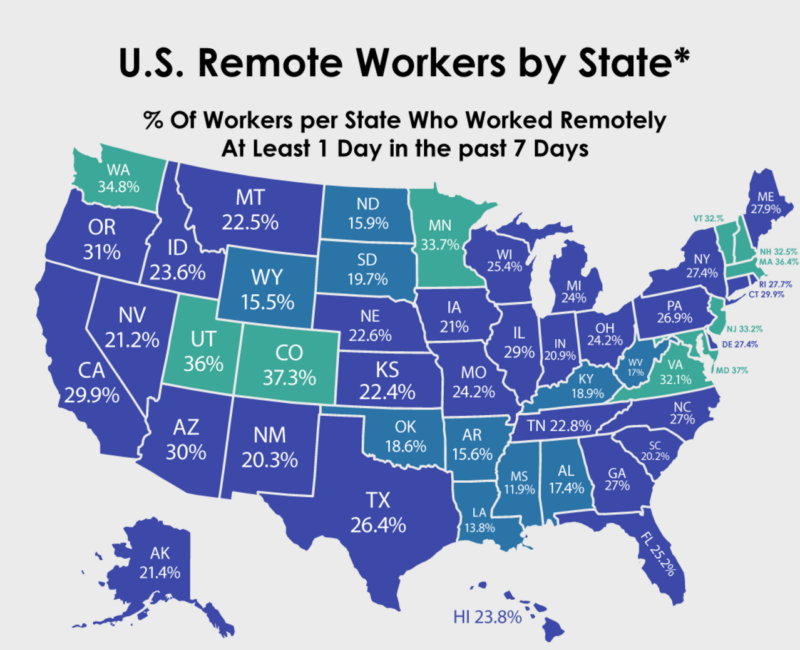Is remote work just a trending topic, or is it a viable way of life? In most remote work conversations, the assumption is that employers instinctively recoil from the idea while technologists plead for the opportunity. There’s a little more than meets the eye when setting remote work expectations for yourself or your business.
In this blog post, we explore the evolving landscape of remote work, debunking common myths and highlighting its benefits for both employers and technologists. We’ll discuss strategies to overcome challenges like burnout and isolation and provide tips for maintaining effective communication. Additionally, we’ll delve into hybrid work dynamics, continuous learning, and networking remotely to ensure a sustainable and productive remote work environment.
Debunking Remote Work Myths
Let’s clear up four common remote work misconceptions right off the bat:
- Remote workers are less productive – With fewer distractions and no commutes, remote workers are statistically more productive than their in-office counterparts. A two-year Stanford study found that remote workers in one company completed an extra day’s worth of work per week compared to their non-remote peers.
- Communication suffers – Collaboration can still thrive via phone or video calls, and over half of remote workers connect with their manager one or more times per day. Plus, research shows that companies with remote workers score high in employee engagement.
- Few companies allow remote work – Although some are reluctant to adapt, 70% of professionals around the world work remotely at least one day per week, with 50% working remotely at least half of each week.
- Working from home is easy – A remote working day is not a vacation day, nor taken lightly. 77% of workers get more done remotely than in the office, and it’s by working hard.
Secure and Keep Technologists with Remote Work
Do you want the best technologist or the best available technologist willing to work in an office? When a business doesn’t contemplate offering remote work, it alienates a large portion of technologists who will only consider more flexible jobs. By opening your recruiting process to include remote employees, you gain access to an enormous talent pool that includes the cream of the crop. Not only does this attract prospective technologists, but remote workers are happier employees. In the aforementioned Stanford remote work study, retention of remote employees improved by 50%.
Offering remote work doesn’t have to be an all or nothing initiative. At BridgeView IT, our internal staff works remotely one day per week. For other companies, the right balance could be one day per month or three days per week. Not every company or employee operates the same way, but remote work helps unlock the full potential of your resources. With younger generations gaining a presence in the technology industry, it’s important to remember they are digital natives who grew up communicating remotely, making many of them natural remote workers. Based on aggregated US census Bureau Reports Jan-Sep 2025, states like our home state of Colorado lead highest percentage of people regularly working from home at least one day a week, at an average 37%. In contrast, just 12% of people in Mississippi work from home on a regular basis – the lowest percentage in the country.

Of course, managing a remote workforce requires strong communication, along with a simple plan and set of expectations. While that will require extra effort from managers, fewer in-office employees produces a cost savings on office space and utilities. On top of that, some technologists may take a slightly smaller salary for the opportunity to work remotely, and that can help your technology hiring budget. As you consider all of this, remember: if you can’t trust your employees to work remotely at least sometimes, why hire them at all?
Overcoming Remote Work Drawbacks
Remote work brings undeniable benefits, but it also presents challenges such as burnout, isolation, and communication gaps. Here’s how employers and technologists can tackle these issues effectively:
1. Combating Burnout
- Encourage Regular Breaks: Promote the use of techniques like the Pomodoro method or schedule non-working time during the day to prevent overworking.
- Set Clear Work Hours: Establish expectations around availability to help remote workers maintain boundaries and avoid working late into the night.
- Provide Mental Health Resources: Offer access to virtual counseling, meditation apps, or stress management workshops to support remote employees’ well-being.
2. Reducing Isolation
- Foster Team Connection: Schedule regular virtual coffee chats, team-building activities, or even casual “water cooler” sessions via tools like Slack or Microsoft Teams.
- Buddy Programs: Pair employees with colleagues for regular check-ins, ensuring everyone feels connected to the team.
- Encourage Community Engagement: Suggest joining local coworking spaces, meetups, or industry events to build in-person relationships.
3. Bridging Communication Gaps
- Use the Right Tools: Implement collaboration platforms like Slack, Zoom, or Trello for seamless communication and project management.
- Create Communication Norms: Establish guidelines for response times, meeting etiquette, and preferred communication channels.
- Prioritize Face-to-Face Interaction: Schedule periodic in-person meetings for hybrid teams or virtual team retreats for fully remote setups.
Navigating Hybrid Work Conflicts
Hybrid work introduces unique challenges, particularly around perceived fairness between in-office and remote employees. Here’s how to create a more equitable environment:
1. Equal Opportunities for Advancement
- Transparent Performance Metrics: Ensure that career advancement is tied to measurable outcomes, not visibility or “face time.”
- Inclusive Leadership: Train managers to provide the same level of feedback and support to both remote and in-office employees.
2. Unified Communication Strategies
- Shared Communication Channels: Use tools like Slack or Microsoft Teams for team-wide updates so all employees receive the same information simultaneously.
- Hybrid Meeting Practices: Rotate between in-office and remote participants leading meetings, ensuring everyone has a voice.
3. Balance Flexibility
- Office Hotdesking: Offer in-office spaces for remote workers to use when they visit, fostering a sense of belonging.
- Company-Wide Remote Days: Implement occasional remote days for everyone, reducing any divide between office-based and remote employees.

Learning and Networking Remotely
For technologists, continuous growth and professional networking are essential, even when working remotely.
1. Upskilling in Remote Environments
- Online Courses: Platforms like Coursera, Udemy, or LinkedIn Learning provide certifications in programming, cloud computing, and other high-demand tech skills.
- Hackathons and Coding Challenges: Participate in online hackathons or platforms like LeetCode to sharpen technical skills and collaborate with peers.
- Webinars and Virtual Conferences: Stay updated on industry trends through webinars hosted by organizations like Google, Microsoft, or AWS.
2. Networking Remotely
- Engage in Online Communities: Join platforms like GitHub, Stack Overflow, or LinkedIn Groups to connect with other professionals in your field.
- Schedule Virtual Coffee Chats: Reach out to colleagues, mentors, or potential connections on LinkedIn for informal discussions about your industry.
- Attend Virtual Events: Look for remote-friendly conferences or job fairs to expand your network and learn about opportunities.
How Technologists Find and Keep Remote Roles
When you’re a technologist, the interview process is the critical time to gauge how open a potential employer is to the idea of remote work. The best-case scenario is that they already have a remote work policy in place, but if not, or if you wish to ask for remote work in your current role, it’s time to come up with a plan. Do your homework and make a proposal, perhaps including a trial run, and be specific. State how you plan to stay in communication, what tasks you’d be working on remotely, what your remote working space would look like, etc. Doing so makes it as easy as possible for your supervisor (or potential supervisor) to say yes.
Once you’re working remotely, know that your work product might be under a bigger microscope than before. Taking too long to answer an email or reply to a missed phone call could raise questions. Make sure you’re on an instant messaging platform like Skype or Google Chat so that you’re easily available, offering a virtual way for your manager or coworkers to knock on your office door. It’s an employer’s worst fear that their remote workers will become disconnected from the company, so alleviate these concerns by staying responsive.
To set yourself up for success, you must have your own remote working space. If working from home, make sure there’s a dedicated room free from kids, significant others, TVs, and your personal life. It’s also a good idea to find local libraries, coffee shops, or coworking spaces where you know you can be productive. While remote work is a great perk, it can be easy to lose true work-life balance if you’re not careful. Don’t burn out by working regularly into the evenings or weekends. Remote workers will often keep working even while sick, which only negatively impacts health and degrades the work product. Think carefully about your time, and you can successfully be a remote working technologist.
Setting Remote Work Expectations
Working from home isn’t just a novelty, it’s the future of many roles in technology. In fact, remote workers who have been in their remote roles for 3-5 years feel happier and more valued than when they first began their jobs. That alone proves it can be a feasible long-term setup that is mutually beneficial for technologists and the companies who rely on their skills. Set your expectations accordingly, and your career or business can thrive in a modern and efficient way.
Making Remote Work Sustainable
Building a long-term remote career requires strategic planning and disciplined habits.
1. Build a Structured Work Routine
- Dedicated Workspace: Set up a home office that minimizes distractions and fosters productivity.
- Daily Schedules: Block specific times for focused work, meetings, and breaks to create a predictable rhythm.
2. Maintain Visibility
- Regular Updates: Proactively share progress on projects with your manager to ensure alignment and visibility.
- Seek Feedback: Regularly check in with your team or manager to refine your work and demonstrate growth.
3. Develop a Career Plan
- Set Long-Term Goals: Define what you want to achieve in your remote role, including promotions or transitioning into new areas of expertise.
- Stay Open to In-Person Opportunities: Even in a remote setup, occasional in-person collaboration or attendance at industry events can help you stand out.

FAQs: Remote Work Expectations for Employers and Technologists
The main challenges include:
• Burnout: Remote workers often struggle to maintain boundaries, leading to overwork.
• Isolation: A lack of in-person interaction can lead to feelings of loneliness.
• Communication Gaps: Misunderstandings can arise without face-to-face communication, especially in teams spread across different time zones.
Employers can:
• Encourage regular breaks and promote work-life balance.
• Set clear expectations for work hours and discourage after-hours work.
• Provide mental health resources, like virtual therapy sessions or wellness programs.
To promote fairness:
• Use transparent performance metrics to evaluate employees based on results, not presence.
• Ensure equal access to information and resources through shared communication channels.
• Rotate leadership roles in meetings and decision-making to include both remote and in-office employees.
Popular tools include:
• Slack or Microsoft Teams for instant messaging.
• Zoom or Google Meet for video conferencing.
• Trello, Asana, or Monday.com for project management and task tracking.
Technologists can:
• Take online courses and certifications from platforms like Coursera, LinkedIn Learning, or Udemy.
• Join online communities (e.g., GitHub, Stack Overflow) to network and share knowledge.
• Participate in webinars, hackathons, and virtual conferences to stay current on industry trends.
To reduce isolation:
• Engage in regular virtual social activities with coworkers.
• Join coworking spaces or attend local meetups to interact with peers.
• Schedule informal check-ins or virtual coffee chats with team members.
Successful remote workers typically have:
• Self-Discipline: The ability to stay focused and productive without supervision.
• Powerful Communication Skills: Keeping managers and colleagues informed proactively.
• Adaptability: Quickly adjusting to changes in tools, processes, or team dynamics.
Productivity can be measured using:
• Task completion rates and meeting deadlines.
• Project milestones or deliverables achieved.
• Employee feedback and engagement surveys.
A strong proposal includes:
• A clear explanation of tasks that can be completed remotely.
• A plan for maintaining communication with the team and manager.
• Details about the workspace setup to ensure focus and productivity.
Trust can be fostered by:
• Setting clear expectations for performance and deadlines.
• Providing regular feedback and recognition for achievements.
• Allowing autonomy and avoiding micromanagement.
To discuss the future of your technology hiring or career, reach out to BridgeView IT today.



